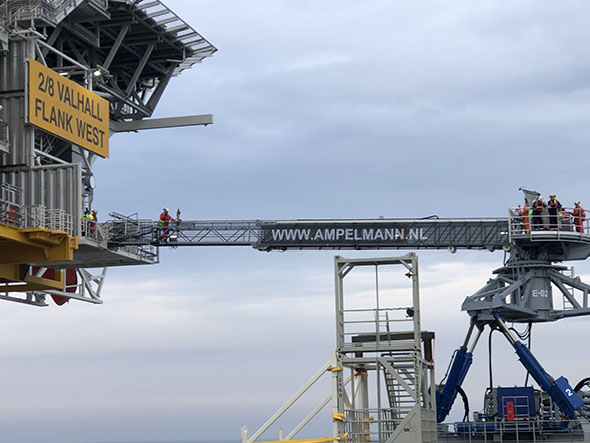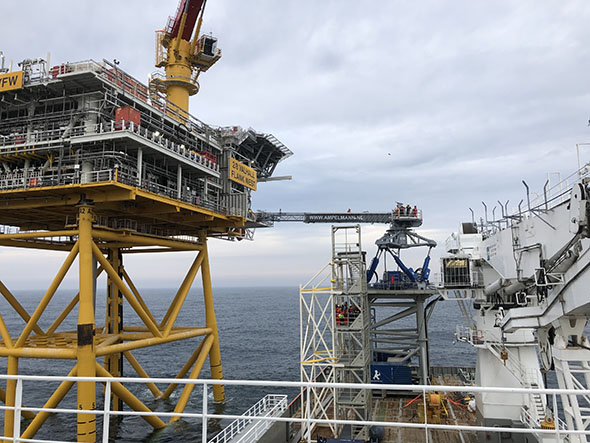Successful “Walk to Work” campaign
 Aker BP has completed the company’s first campaign using a gangway for access from a vessel to an unmanned platform. The campaign was carried out in the first stage of the hook-up phase on Valhall Flank West in the North Sea.
Aker BP has completed the company’s first campaign using a gangway for access from a vessel to an unmanned platform. The campaign was carried out in the first stage of the hook-up phase on Valhall Flank West in the North Sea.
The hook-up of Valhall Flank West started on Saturday, 20 June, just hours after the operation to install the topsides was complete. The early start-up was possible because personnel could be transported to the platform via a gangway on the Normand Jarstein vessel, so-called walk-to-work (W2W).
“Around 100 workers have lived on the vessel and been transported over to the platform. We have completed more than 1300 crossings during the course of this first hook-up phase, which lasted 9 days. The vessel has connected to the wellhead platform 50 times and we have had no system failures,” explains project manager Michael Bible for Valhall Flank West.
“The platform is designed to receive a gangway from a W2W vessel. We have prepared the campaign well. This solution is at least as safe as helicopter transport,” he adds.

John David Beckers is lead W2W engineer for the Valhall Flank West campaign.
Fast and cost-effective
The personnel mobilised on Norman Jarstein on 19 June in Stavanger. The vessel left the Valhall field once the campaign was successfully completed.
“Use of the W2W vessel has allowed us to increase the number of people working on the unmanned platform in this phase of the hook-up operation, compared with what would have been the case if we had to rely on helicopters to transport the personnel,” says the project manager.
“We have thus completed the campaign in a safe, predictable, fast and cost-effective manner, as compared with using helicopters. All work has been delivered according to plan and feedback from our personnel is that they too have experienced W2W as a safe and efficient work method,” Bible emphasises.
The gangway technology on board Normand Jarstein was delivered by the company Ampelmann. In general, the equipment can operate in significant wave heights of up to approximately 2.5 metres, but this is also dependent on other factors such as wind direction and wave periods. In this campaign, the bridge was disconnected, and the vessel moved away from the platform after each transfer of personnel.
A solution for the future
Aker BP’s goal is to establish a practice for using vessels with gangways for transport and accommodation of personnel who are to work on normally unmanned platforms. Use of W2W vessels for transporting personnel is a known and accepted solution outside the Norwegian continental shelf, both within the oil and gas industry and within renewables. W2W has also been used previously on the Norwegian shelf.
“Introducing W2W supports our first and foremost priority – safety for personnel,” says Valhall manager Per Mikal Hauge.
“There are more and more unmanned platforms on the Norwegian shelf, and they are also an important part of Aker BP’s strategy for future developments. The Valhall Flank West campaign that has been implemented safely and efficiently is therefore important in Aker BP’s path to establish this as a practice,” concludes Hauge.
The Maersk Invincible rig is now in place on the field. It will drill wells and function as an accommodation rig through the remainder of the hook-up and commissioning work on Valhall Flank West.
Production start-up from Valhall Flank West is planned in the fourth quarter of 2019.
